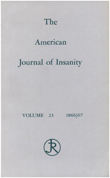Sexual behavior of homeless mentally ill men at risk for HIV
Abstract
OBJECTIVE: The authors investigated sexual behaviors related to HIV transmission among homeless mentally ill men in a New York City shelter. A previous study of a similar population found HIV prevalence to be 19%. METHODS: In standardized interviews with 122 men, data on sexual behaviors for the previous 6 months were collected. The frequency and nature of sexual episodes that may facilitate HIV transmission were examined. In addition, sexual risk behaviors among broadly defined diagnostic groups were compared. RESULTS: Of the 122 men, 65 (53%) had sex, 56 with women and 20 with men (11 who had sex with both women and men are counted in each group). The sexually active men, in most cases, had only occasional sex (once per month or less). The majority of sexually active men--29 (52%) of those who had sex with women and 12 (60%) of those who had sex with men--had sex without a condom and with nonmonogamous partners. Comorbid cocaine abuse or dependence was significantly associated with high-risk sexual behaviors. CONCLUSIONS: The majority of these men had sex occasionally or not at all. Nonetheless, because many of them had unprotected sex with nonmonogamous partners, the few sexual episodes may have carried an appreciable risk of HIV transmission. Moreover, men with a comorbid cocaine dependence may represent a group with an especially high risk for sexual HIV transmission. The authors propose that in this population, preventive interventions could modify the nature, if not the frequency, of sexual episodes.
Access content
To read the fulltext, please use one of the options below to sign in or purchase access.- Personal login
- Institutional Login
- Sign in via OpenAthens
- Register for access
-
Please login/register if you wish to pair your device and check access availability.
Not a subscriber?
PsychiatryOnline subscription options offer access to the DSM-5 library, books, journals, CME, and patient resources. This all-in-one virtual library provides psychiatrists and mental health professionals with key resources for diagnosis, treatment, research, and professional development.
Need more help? PsychiatryOnline Customer Service may be reached by emailing [email protected] or by calling 800-368-5777 (in the U.S.) or 703-907-7322 (outside the U.S.).



